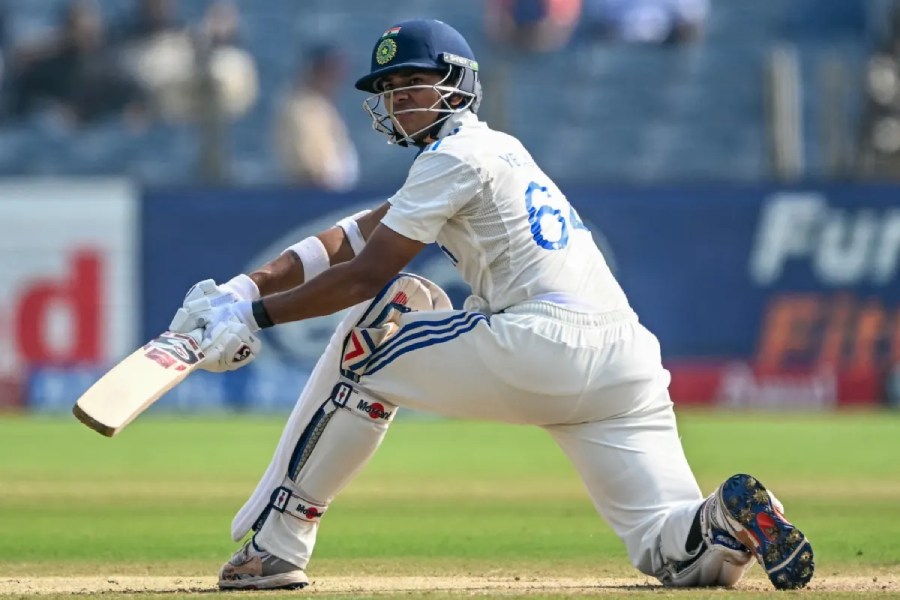Yashasvi Jaiswal was perhaps the only top-order India batter who trusted his defence in the recent series against New Zealand.
The opener lunged forward and across to get in line of the ball, never allowing the Decision Review System (DRS)-leg before rule to ruin his technique. But a suicidal reverse sweep towards the end of the opening day of the final Test at the Wankhede brought about his dismissal.
A high-risk shot on a spiteful surface was least expected from a batter whose game has been nurtured in the strict sense of the Mumbai gharana and is considered to be technically perfect. His indiscretion cost one wicket too many within a space of eight deliveries.
This nature of collapses was contagious right through the three Tests, sparking a rare series whitewash at home much to the embarrassment and disbelief of the fans. There was a farcical nature to the home team’s batting reflected in the third day finish to the Test matches in Pune and Mumbai. The opener in Bengaluru stretched to the final day but only because the first day had been washed out.
Across the border, Pakistan wrapped up the last two Tests against England in Multan and Rawalpindi within four and three days, respectively, after Sajid Khan and
Noman Ali consigned Bazball’s ultra-flamboyant approach to ashes.
Geoffrey Boycott was left fuming at the woeful application of their batters.
“If you want to be rated a great batsman, you must have a rounded game, and score runs on all types of pitches,” Boycott wrote in his column for London’s Daily Telegraph.
“They are entertaining and fantastic to watch because you never know what they
are going to do next, good or bad, but Ben Stokes and Brendon McCullum want their team to be the best. Unfortunately, they are wasting their opportunity...
“As soon as the ball grips, Zak Crawley, Ollie Pope, Harry Brook, and Stokes are all at sea. They go at the ball with hard hands, and there are gaps between bat and pad,” Boycott said.
Boycott, who grew up embracing the traditional virtues of the game, had reasons to feel aggrieved. He played in an era where he could afford to be a player first and then an entertainer. He was allowed to grind for hours without scoring a run, often tiring the bowlers. Did it leave the spectators bored? That’s debatable.
The advent of limited-overs cricket has changed the perspective but its effect on the traditional format is open to debate. Today it’s more about theatrics, showbiz and a bit of adventure.
The immediate fallout has been the batters’ inability to survive for long sessions at the crease. Forget a Boycott or a Sunil Gavaskar, even a Rahul Dravid or Cheteshwar Pujara’s dour approach and the ability to grind the opposition out of the match seem out of fashion.
When Gavaskar was dismissed by Iqbal Qasim in his final Test innings on a crumbling minefield at the Chinnaswamy, he had battled for 264 balls in 320 minutes for his 96. The Indian innings lasted 175 balls and 282 minutes when they fell 25 runs short of the 147-run target in the final Test against New Zealand.
Surviving more than a day seems almost irrational, triggering a drastic slide in the number of days of Test matches. In the last five years, only five of the 24 Tests played in India went into the fifth day while over a period of 10 years, 17 of the 50 Tests stretched into the final day.
The ICC even contemplated four-day Tests before the current Future Tours Programme in early 2020, but the outpouring of love from the players and coaches forced its cricket committee, then led by Anil Kumble, to move away from the thought of diluting the format. None wanted to lose the insurance the presence of a fifth day brings, especially in case of rain.
More often than not, the quality of batting has to be blamed for the reduction in duration. The new generation lacks the aura and charisma which define Test match batting.
Kevin Pietersen too lamented the falling standards of batsmanship in Tests, terming it as a “smacker’s game”.
“No one should be surprised by the lack of batting application and technique in Test Match cricket. Cricket is a ‘smackers’ game now and there is a disintegration of Test Match batting skill in the game,” Pietersen wrote on X. “When it comes to playing spin, the only way, spend time playing against it for hours and hours and hours. There’s no quick remedy!”
The Indians’ temperament and inability to bat on turners have come in for a lot of flak in the last series. Presenting a ‘dead bat’, a key element of the defensive technique is now outworn.
The new-age batter, because of the proliferation of limited overs cricket, often pushes hard at the ball. Edges, instead of falling short, carry to the slips as a result.
A key element of the defensive technique is that if the bat is held with a light grip then the ball loses the momentum on striking it and falls harmlessly to the ground. It remains one of the key virtues of building an innings, which is significantly absent in modern day batting.
Add to it the DRS which has taken the front-foot pad play out of the batter’s book. A batter isn’t comfortable applying the pad as the first line of defence against the spinners for fear of DRS-lbw coming into effect. Even a Virat Kohli’s front leg is straight down the leg-stump line.
“You play with hard hands only when you are not sure about your defence. You tend to play away from your body. The ball will then control you and you are at the mercy of the ball,” former India opener and national selector Devang Gandhi told The Telegraph.
“It’s not that we’re playing on turners for the first time. Earlier we could score around 500 and then skittle out the opposition. Those were the days of the Tendulkars, Sehwags, Dravids, Laxmans and Gangulys.
“The modern-day batter doesn’t realise that it is very difficult to drive on turning wickets. You have to play off the back foot or play late. Once you are committed to the front foot, your scoring options are limited,” Devang, who knew well how to tame spinners, said.
Devang also blames the temperament of the batters. “The ability to grind it out is forgotten. You have to play the waiting game.”
Temperament — a combination of the mental, physical and emotional traits — often helps the batter to stand up and carry the day. This demands test of character.
Sports psychologist Sandy Gordon, who worked with Team India during the 2003 World Cup, often urged the players to follow a simple exercise inside their hotel rooms to improve concentration — focus on the light in a dimly-lit room to trust the body and mind to work together.
“There is probably a greater premium on temperament for a batsman than for any player in any branch of sport. The batsman is not allowed one error. Is it any wonder temperament plays such an enormous part in batting?” Don Bradman says in Art
of Cricket.
Application and temperament are attributes which often separate the greats from the ordinary. The foundation of an innings is built on their resilience and determination.
The dearth of a Dravid or a Pujara in modern-day cricket is significant. An Usman
Khawaja or a Steve Smith can bat for long periods but has been let down by lack
of consistency.
Even a classical bat like Joe Root has been bitten by the Bazball bug, his repeated attempts to reverse scoop in Test matches bear testimony to it. Such suicidal tendencies often lead to early finishes as was evident during England’s last tour of India.
During India’s first series win in Australia in 2018-19, Pujara faced 1258 balls, the most for a visiting batsman who played four Tests in a series Down Under. Unless India
can find his replacement in their line-up, it will be tough to retain the Border-Gavaskar Trophy.
Refusing to grimace in the face of body blows, the ability to gulp down the pain and never flinching in the face of pace — that define batting in Australian conditions. Else, early finishes to Tests will be the norm.










